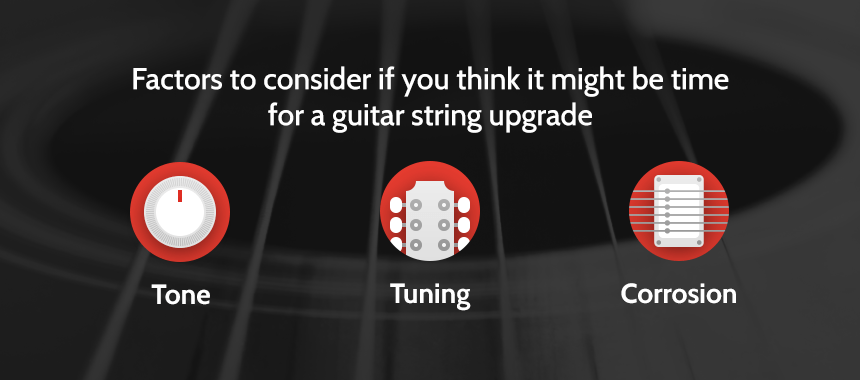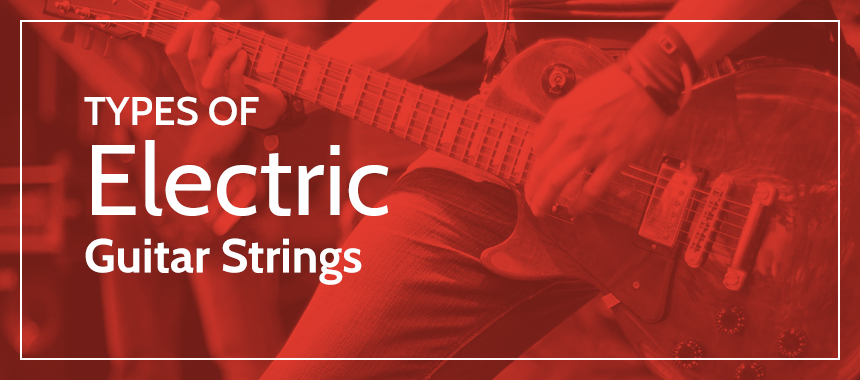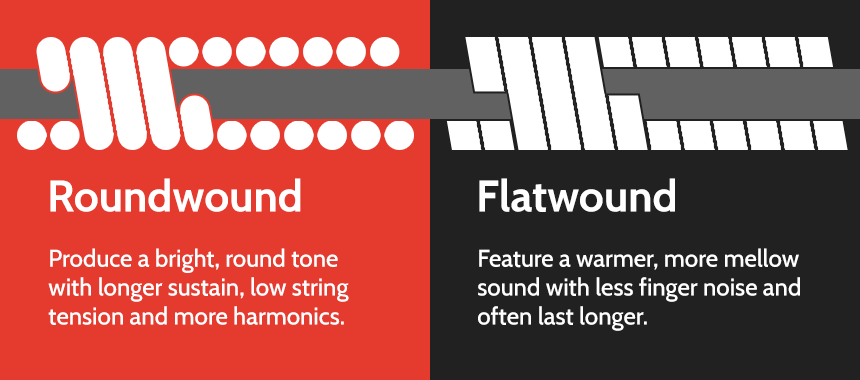
Complete Guide to Guitar Strings
With different gauges, types and brands to choose from, how do you know which guitar strings are right for you and your guitar, especially if you're a beginner just starting out?
While there is no perfect formula for finding the right guitar strings, this guide to guitar strings will help you navigate your playing and style preferences to find strings that fit your instrument and your style. Different guitar strings can influence the tone of your guitar, and provide different benefits and challenges. Finding the right guitar strings is well worth the effort because the proper strings can help you achieve the sound you're striving for.
When to Change Guitar Strings
The first question many new guitar players ask is how often they should change their guitar strings. There is not a simple, single answer to that question — some guitarists change their strings only once a month, while others change strings a few times a week. Many factors determine how often you should change your guitar strings, and these vary among players, instruments and playing habits. Here are a few factors that influence when to change your guitar strings:
- How often you play: The more often you play your guitar, the more quickly your strings will become worn out. Guitar strings wear out mainly because of corrosion caused by the oils in your skin. Collection of dirt and general wear from playing also cause strings to age more. If you only pull out your guitar every few days, your strings may last for a few months, but if you are strumming away for hours every night, you will burn through guitar strings faster.
- How hard you play: Everyone has a different playing style, and while we would never say one is better than another, your guitar strings will wear out more if you tend to strum hard or pick aggressively. If your style involves a lot of string bending, you can expect your strings to lose tension and quality more quickly. If you are more of the gentle acoustic type, your strings will likely last longer.
- How well you maintain your guitar: Keeping your guitar clean will help the strings last longer. When you play in a dirty or smoky environment, the strings become corroded more quickly. If you wipe down your strings after playing and store your guitar in a clean environment, you will not need to change your strings as often.
- Level of professionalism: Perhaps the most significant factor that influences how often you should change your strings is how much you care about sound quality. The age of your guitar strings will impact the quality of your tuning and tone, and new strings will produce a clearer sound. If you play guitar for fun and are not too concerned about perfect tone or clarity, you can play on old guitar strings longer. On the other hand, if you are recording or performing frequently, you may want to change your strings more often to achieve a bright, clean sound versus
A good way to think about changing your guitar strings is the same way you would think about replacing running shoes. If you run every day, you will wear out the soles of the shoes faster. If you run in the rain, your running shoes will also deteriorate more quickly. If you only go on a run once a week and keep your shoes clean and dry, they will stay in good condition for a longer time. The same concept applies to your guitar strings. However, compared to a worn-out shoe, it takes more experience and practice to be able to see — or hear — when a guitar string needs replacing.
Many talented guitar players never change their strings until one breaks. In the end, it is all about your personal preference.
How to Tell When It's Time to Change Guitar Strings
Since it varies from person to person, how do you know when you should change your guitar strings? By paying attention to the sound and condition of your guitar, you can recognize when it's time to change your strings. Here are a few factors to consider if you think it might be time for a guitar string upgrade:

- Tone: As your strings experience wear and tear, it affects the way they resonate and sustain — which, in turn, alters the tonal quality of your instrument. New strings will sound bright and clean, while old ones sound flat and dead. When you are new to guitar, it can be difficult to discern this subtle decline in tone as your strings age. However, when you do change the strings on your guitar, the difference in tone is often striking.
- Tuning: Worn-out guitar strings are also more difficult to get in tune and keep in tune. If you primarily play casually or on your own, this may not be as important to you. However, if you play in a band or with friends, keeping your guitar in tune is essential to a consistent and high-quality sound.
- Corrosion or breakage: If you look closely at your guitar strings or compare them to a new set, you may be able to see discoloration or rust on older strings. Sometimes, you may even see the wire peeling away from the string as it corrodes. This deterioration of your guitar strings will make them more likely to break, which can be a major inconvenience if you are on stage performing when it happens — although some players love the hardcore vibe of playing until their strings burst.
The longer you play your instrument, the better you will become at recognizing the signs it is time for a string change. By paying attention to how frequently your strings become worn out, you can better anticipate when you need to change your strings and prevent them from breaking.
How to Make Guitar Strings Last Longer
Even if you play your instrument very frequently, there are still a few ways you can increase the lifespan of your guitar strings so they provide quality sound longer:

By taking care of your instrument and strings, you will earn more life out of your guitar strings and experience better-quality sound.
How to Choose Guitar Strings
Different strings will bring out unique tonal qualities in your guitar because the material and size cause each string to vibrate distinctly. Even the same material and size of the string may sound different across various brands due to changes in manufacturing processes.
The best place to start is to know what kind of music you want to play and what type of sound you hope to produce. Do you want a smooth, mellow guitar for folk music, or do you want your instrument to sing out sharp, crisp notes for rock and roll? The type of strings you buy will have a tremendous impact on how your guitar sounds and the style you create.
Guitar strings vary in a few different ways, including the size or gauge, the type of material they are made of, the way they are wound and the company that produced them. With a little knowledge, you can make an informed purchase and find great strings for your guitar. In the next few sections, we will break down each of the different qualities of guitar strings to help you select the perfect set.
Guitar String Sizes

The size of a guitar string is called the gauge and is a measurement of the diameter of the string. The thickness of a set of strings is often based on the thinnest string, the high E string, measured in thousands of an inch. So, if the gauge of a set of strings is nine, that means the E string is 0.009 inches thick. The rest of the strings have a proportional thickness that allows players to tune their guitar properly and the strings to have appropriate tension.
For most guitars, there will be a "correct" gauge size to use, so the strings will have the right tension and sit the proper distance above the fingerboard. That doesn't mean you can't change the gauge of your guitar, but you might need to have your guitar modified to accommodate a different gauge. This setup may involve a bridge or neck adjustment. The primary reason to change the gauge of your guitar strings is for comfort while playing, as heavier gauges are more difficult to strum than lighter gauges. However, the string gauge also has an impact on the tone and sound of your guitar.
For electric guitar, the most comfortable string gauge typically falls between nine and 11 for most people. However, thicker and thinner strings are available. If you are just getting started, begin with a string gauge in this range, then adjust as necessary. The most popular gauge for electric guitar strings is 10. For acoustic guitar, heavier gauges are more common because the vibrations of the strings need to be strong enough to resonate in the body of the guitar and amplify the sound.
Generally speaking, lighter gauges will be easier to play and produce more treble tones, while heavier-gauge strings will be more difficult to strum and produce more bass tones. Here are a few more differences between lighter and heavier guitar strings.
Light-gauge guitar strings have the following characteristics:
- Lower string tension and stress on the guitar neck
- Easier to strum or pick
- Lighter and "tinnier" sound
- Better for string bending and fretting
- Produce less volume
- Somewhat less stable tuning
- More prone to breakage
- Can cause fret buzzing
- More string tension and stress on the neck
- More challenging to strum or pick
- Stronger bass tones and darker sound
- Better for hard playing or strong picking
- Preferred for alternative and low tunings
- Produce more volume and sustain
- More stable tuning
- Less prone to breakage
When you first purchase strings, it is easiest to buy a pre-packaged set with the appropriate gauge for each string. However, as you progress as a guitarist, you may want to experiment with a hybrid string gauge. Using heavier low strings and lighter high strings can allow you to strum hard on the bottom strings and bend the top ones easily.
Types of Electric Guitar Strings

On a standard six-string electric guitar, there are three unwound and three wound metal strings. All of the strings are made of the same core metal, and the wound strings have an additional winding wire wrapped around the core to make them thicker. Electric guitar strings can be made from several different metals, which each offer unique benefits and challenges.
Here are a few of the most popular metals for electric guitar strings:
- Nickel-plated steel: Guitar strings made of nickel-plated steel have a steel core with a thin coating of nickel on the outside. This hybrid metal is one of the most popular options for electric guitar strings, as they are versatile enough to work for almost any genre. Nickel-plated steel strings provide a tonal balance of both smooth and warm and bright and snappy. These strings have an even and comfortable feel, while still offering strong pick attack for more defined articulation.
- Stainless steel: Sharp and powerful, stainless steel guitar strings produce a bright attack and a crisp sound. A benefit of stainless steel strings is that they are resistant to corrosion, so they can last a long time. They also tend to have less finger squeak than other strings. A downfall to stainless steel strings is that they are physically harder than most other strings, so they can be painful on your fingers if you are just starting out.
- Pure nickel: If you are seeking a warm and mellow tone, pure nickel guitar strings are for you. The soft and smooth tone of nickel guitar strings is reminiscent of a vintage guitar sound, making them desirable for players who want to emulate years gone by.
- Other metals: While nickel-plated steel, stainless steel and pure nickel are the most common string types, you can experiment with a variety of other metals for your guitar strings. Cobalt is a dynamic guitar string option that offers a wide range of tones and has a reputation for producing a bright, powerful and clean sound. Cobalt strings also have great pickup response. Like stainless steel strings, cobalt is hard and can be tough on your fingers. Titanium is another strong guitar string material that produces a bright tone. Titanium strings are also very durable and have a long lifespan. Chrome and copper guitar strings are softer options that produce warm tones and low resonance. However, because they are softer, they are also more prone to breakage.
Each person is different, and for some people, the oils in your skin may react poorly to certain metals and cause the strings to corrode more quickly. You should also keep in mind the frets on most guitars are nickel, so using stainless steel or another hard metal may cause them to wear out faster, whereas softer metals like nickel will not. Replacing a fret is a lot more expensive than changing strings, but you may want to take the risk of harder strings to produce a sound you love.
Luckily, in contrast to gauge, which is more difficult to adjust, you can try a variety of different metals for your guitar strings without making any other adjustments. It allows you to experiment with different sounds until you find the right strings for you.
Types of Acoustic Guitar Strings

For acoustic guitars, there are only two common materials for strings, but each produces a very different sound. You will have to determine what type of music you want to make to choose which type of strings are best for your acoustic guitar:
- Phosphor bronze: A suitable choice for any genre, phosphor bronze guitar strings produce a full and smooth tone with medium brightness. Phosphor bronze strings are particularly excellent for those who want to produce a mellow and round sound. These brass-colored strings resist corrosion to last longer.
- 80/20 bronze: For more brightness and pick attack, 80/20 bronze guitar strings are the right choice. These copper-colored strings are also called bronze/brass strings and produce crisp and sharp tones. A downfall to 80/20 strings is that they are not as resistant to corrosion and tend to wear out more quickly than phosphor bronze strings.
Types of Classical Guitar Strings

String material primarily distinguishes classical guitars from their acoustic and electric counterparts. While classical guitars have the same wooden body type and shape as acoustic guitars, their strings are a softer material such as nylon, nylgut or carbon fiber instead of metal.
Classical guitar strings were traditionally made from the innards of farm animals and called "catgut" guitar strings. The production of nylon strings has now replaced that practice, as it is more affordable and morally acceptable.
Below are a few of the common types of classical guitar strings in use today:
- Nylon: As the most popular choice for classical guitar, nylon strings produce a clear tone and are fairly affordable. Nylon strings are soft to pluck and provide the mellow tone that characterizes classic guitar, while also allowing for a bright attack. A variety of nylon strings are available, but the most common are clear, black or rectified nylon. Nylon strings are typically a smart choice for recording, as they produce a smoother sound. One downfall to nylon strings is that they can produce a large difference in volume between the wound bottom strings and the top strings.
- Nylgut: Nylgut guitar strings provide the closest sound to traditional catgut guitar strings, without requiring animal intestines to produce them. While catgut strings are also very prone to snapping, artificial nylgut strings are much longer-lasting.
- Carbon fiber: A newer option for classical guitar strings, carbon fiber strings produce a louder and brighter sound than nylon strings. Carbon fiber strings are an excellent option for performing, due to their higher volume and increased ability to project sound. A downfall to carbon strings is that it can be harder to produce vibrato. They are also rougher on the fingers than nylon guitar strings.
Roundwound vs. Flatwound Guitar Strings
In addition to different gauges and metals, guitar strings can be either roundwound or flatwound. This feature only applies to the bottom three strings that have a wire wrapped around the metal core.
Roundwound guitar strings have a round wire wrapped around the core metal, while flatwound have a smooth wire. Most guitar players will not stray from traditional roundwound strings, but flatwound strings can produce a unique sound for those who do.

Here are some differences in tone and playing style of roundwound and flatwound guitar strings:
- Roundwound: These guitar strings produce a bright, round tone with longer sustain, low string tension and more harmonics. The round wire also creates a ridged texture that makes them easier to grip. Two downfalls to roundwound strings are that they produce more wear on the frets and lead to more finger squeak. Roundwound strings are a traditional choice and are much more common than flatwound strings.
- Flatwound: These guitar strings feature a warmer, more mellow sound with less finger noise and often last longer than roundwound strings. The flat surface of flatwound strings allows an easy slide and smooth sound that makes them popular with jazz guitarists.
Uncoated vs. Coated Guitar Strings
Uncoated guitar strings have been the standard for years, but coated guitar strings are gaining popularity. This fairly new technology uses polymer webbing to coat the strings to protect against corrosion and oxidation. Coated guitar strings have a longer lifespan, meaning you will not need to purchase new strings as frequently. Coated strings also have less finger squeak and provide a consistent sound that is ideal for recording. However, because of this coating, it also means the string does not vibrate as much, which influences the tone and output of your playing.
How to Find the Best Guitar String Brand
Once you have chosen the right gauge and metal type for your playing style, you will have to determine which brand suits you best. Because of differences in manufacturing practices, each brand will offer a subtly different sound, even between the same gauge and type of guitar strings. The good news is that guitar strings are relatively affordable, so you can experiment a bit to find a brand you love.
 Finding the right guitar strings for your guitar and your playing style will take some trial and error. Don't be afraid to buy a few different packs to test out and listen for the subtle tonal and quality differences. Once you begin to develop your unique style, you will know which strings complement your music best.
Finding the right guitar strings for your guitar and your playing style will take some trial and error. Don't be afraid to buy a few different packs to test out and listen for the subtle tonal and quality differences. Once you begin to develop your unique style, you will know which strings complement your music best.
When you have found your perfect strings, keep an eye on their cleanliness and condition to determine how often to change them. Keep track of when you change your strings, so you don't get caught off-guard by a string snapping and can maintain a clean and beautiful sound. If you really jam out, you may want to have a few extra packs of guitar strings on hand — just in case one of them breaks in the middle of an intense performance. Investing in a string winder is also a great idea for faster guitar string changes.
Guitar Strings From Bananas at Large
At Bananas at Large, we offer a wide variety of guitar strings from all the best brands, including D'Addario, who is the world's leading manufacturer of fretted strings. Shop our guitar strings online to find the strings you want from our curated collection or head to one of our California locations to chat with an expert about the right guitar strings for your playing style.
If you are not confident about changing your guitar strings yourself, Bananas also offers professional guitar restring services. If you are switching gauges, our guitar experts can perform setup and repair to get your instrument in tip-top shape. Finding the right guitar strings for you will be well worth the effort to produce high-quality sound, no matter what kind of music you play.











